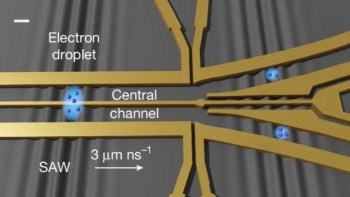In most computers bits of data are stored in one place and processed in another. Now German physicists have proposed a new magnetic approach to computing in which the same element can store and process data. Andreas Ney and colleagues at the Paul Drude Institute in Berlin say that their “programmable logic element” could, in principle, operate as any one of four different logic operations - AND, OR, NAND or NOR gates - and lead to increased computational efficiency (A Ney et al. 2003 Nature 425 485).

The new approach is based on magnetic random access memory (MRAM) elements that contain two magnetic layers separated by a spacer. If the magnetic moments of the two layers are parallel, the electrical resistance of the element is low and this is taken to represent a ‘1’; the antiparallel, high-resistance state is taken to represent a ‘0’. The magnetic moments of the layers can be flipped by passing an electric current through an input line to produce a magnetic field.
The device proposed by Ney and co-workers is based on a single element that has two independent input lines (called A and B: see figure 1). This means that four initial states are possible altogether. These are ‘00’, ‘01’, ‘10’ and ‘11’, where ‘00’ represents a negative current passing through both input lines, ‘01’ is a negative current through A and a positive current through B, and so on. Ney and colleagues show that this set-up is enough to provide storage and the AND and OR operations. And by adding a third input line, they can also reproduce the NAND and NOR operations.
The researchers say that their device has many advantages over transistor-based logic and that it could lead to programmable magneto-logic circuits in the near future. “Since our concept is quite straightforward and is based on existing technology, the fabrication of a reprogrammable magneto-logic circuit is foreseeable in the near future,” said Ney. “Our work is still only a concept, but we intend to make a practical, working device using these ideas.”



